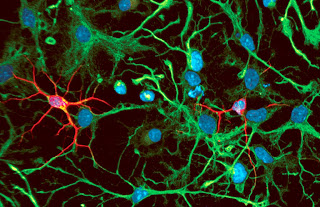Cell Fate and Connectivity Intertwined

The traditional view of neural development is linear. First, the embryo and neurectoderm are patterned by secreted factors, which establish cell fates among progenitors and then differentiated neurons, encoded by combinations of transcription factors. The fate or phenotype of each neuron includes the expression of the specific set of ion channels, neurotransmitters and receptors that determine its physiological function. It also includes expression of a particular repertoire of guidance receptors and surface molecules regulating connectivity, which enable axonal pathfinding and target selection. The processes that establish connectivity are usually thought of as happening after the fate of neurons and their targets have been established. This linear paradigm, from patterning to differentiation to connection, has been increasingly challenged by studies from both invertebrate and vertebrate systems.
A number of studies have shown that incoming axons can regulate the proliferation and differentiation of their synaptic target cells. In many cases in fact, the target cells do not even exist at the time that the incoming axons are making their targeting decisions. In the fly visual system, for example, photoreceptor axons target the developing optic lobe and secrete the morphogen hedgehog, which induces optic lobe progenitor cells to complete a final cell division and undergo neuronal differentiation (Huang and Kunes, 1996). In addition, secretion of additional signaling molecules induces expression in the optic lobe neurons of adhesion molecules and guidance factors necessary for retinal axons to recognize them as appropriate synaptic targets (Bazigou et al., 2007). Thus, the final differentiation of cells in the optic lobe requires the prior pathfinding of retinal axons to this area.
A similar situation has been demonstrated in the mammalian brain, where axons from the visual thalamus induce the proliferation and differentiation of the primary visual cortex (Dehay et al., 2001). Significant patterning of the cortical sheet occurs prior to thalamic axon invasion and directs the guidance of visual thalamic axons to the appropriate part of the cortex (Little et al., 2009). However, ultimate elaboration of the mature cytoarchitectonic characteristics of primary visual cortex, including its pattern of connectivity with other cortical areas, requires correct innervation by visual thalamic axons. Though it has not been shown, it seems likely that this kind of hierarchical dependence on afferent innervation might also be crucial in the elaboration of later-maturing higher-order cortical areas, which receive inputs from earlier-maturing areas (Bargary and Mitchell, 2008).
The linear developmental paradigm must thus be substantially modified to include a highly dynamic interplay between differentiation and establishment of connectivity. Importantly, a recent study suggests that the influence of this interplay also extends to the maintenance of cell fate in the adult nervous system. It is well known that many neurons require retrograde neurotrophic support from their target cells to stay alive. A study from Drosophila (Eade and Allan, 2009) suggests that retrograde signals, in this case involving bone morphogenetic protein (BMP) signaling, may also be required to maintain expression of neuronal phenotype in connecting cells, demonstrated through an effect on expression of a specific neuropeptide. This signaling was shown to require active axonal transport mechanisms. If this mechanism holds in vertebrates it has several important implications. First, neuronal phenotypes in the adult nervous system may be more plastic than previously recognised and more actively maintained by regulators of gene expression in response to ongoing retrograde (and possibly anterograde?) signaling. Second, neurodegenerative disorders involving defects in axonal transport, such as Huntington’s disease, may have their primary effects on neuronal phenotype and physiological function, inducing partial de-differentiation prior to overt degeneration. Therapeutics aimed at preventing this process may thus be able to target the earliest stages of such diseases.
HUANG, Z., & KUNES, S. (1996). Hedgehog, Transmitted along Retinal Axons, Triggers Neurogenesis in the Developing Visual Centers of the Drosophila Brain Cell, 86 (3), 411-422 DOI: 10.1016/S0092-8674(00)80114-2
BAZIGOU, E., APITZ, H., JOHANSSON, J., LOREN, C., HIRST, E., CHEN, P., PALMER, R., & SALECKER, I. (2007). Anterograde Jelly belly and Alk Receptor Tyrosine Kinase Signaling Mediates Retinal Axon Targeting in Drosophila Cell, 128 (5), 961-975 DOI: 10.1016/j.cell.2007.02.024
Cell-cycle kinetics of neocortical precursors are influenced by embryonic thalamic axons.
Dehay C, Savatier P, Cortay V, Kennedy H.
J Neurosci. 2001 Jan 1;21(1):201-14.
Little, G., López-Bendito, G., Rünker, A., García, N., Piñon, M., Chédotal, A., Molnár, Z., & Mitchell, K. (2009). Specificity and Plasticity of Thalamocortical Connections in Sema6A Mutant Mice PLoS Biology, 7 (4) DOI: 10.1371/journal.pbio.1000098
Bargary, G., & Mitchell, K. (2008). Synaesthesia and cortical connectivity Trends in Neurosciences, 31 (7), 335-342 DOI: 10.1016/j.tins.2008.03.007
Eade, K., & Allan, D. (2009). Neuronal Phenotype in the Mature Nervous System Is Maintained by Persistent Retrograde Bone Morphogenetic Protein Signaling Journal of Neuroscience, 29 (12), 3852-3864 DOI: 10.1523/JNEUROSCI.0213-09.2009



I'm always wondering why the universe keeps creating spheres in every creation, been a supernova, galaxy, planet, star, an atom, etc. It is always a sphere, maybe we should pay attention to the sacred geometry that the ancient cultures use.
ReplyDeleterottweiler
Different remedies for illness and different sayings etc
ReplyDeletecheck their website
I would like to thanks for sharing this great blog with us because your work on "Brain" philosophy amazing.
ReplyDelete"Online Logo Design Companies"